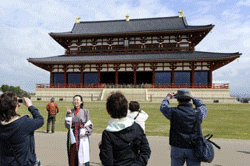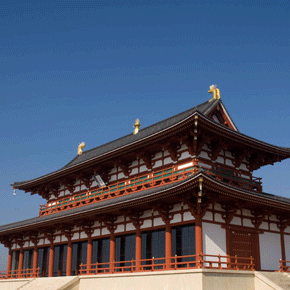
Over the past few months, you may have noticed a cartoon character — a boy Buddha wearing deer antlers — appear on signs in stores, arcades and train stations.
This is not a new attraction at Disneyland or an advertisement for some other theme park but Sento-kun, the official mascot of the Nara Heijo-kyo Capital 1,300th anniversary celebration, which kicked off April 24.
Over the next six months, a variety of events are planned to mark the occasion.
Officials hope the celebration will raise the region’s profile as a major historical tourism destination.
But the events have already drawn criticism from residents over economic and logistical issues, and there has been some controversy over the Sento-kun mascot.
Here are some basic questions and answers about the Heijo-kyo events:
What, exactly, is being celebrated and why ?
In 710, the capital of Japan was moved from Fujiwara-kyo, in a different part of what is now Nara Prefecture, to Heijo-kyo, the palace site that is just a couple of kilometers from the city of Nara.
Over the next 74 years, until 784, Heijo-kyo became the far eastern end of the ancient Silk Road, via trade with Tang Dynasty China and the Korean Peninsula.
The Shoso-in Treasure Repository in Nara holds artifacts from west and central Asia that arrived via China during this time. Buddhism, another cultural import via China and Korea, also became prominent. Numerous Buddhist temples, including Todaiji Temple, which houses the Great Buddha, were built while Heijo-kyo was the capital.
So, in essence, Heijo-kyo was Japan’s first international city ?
The new capital was actually modeled on Chang’an, the capital of Tang Dynasty China, and diplomatic and cultural exchanges between ancient Nara and China took place on a regular basis.
One of the exhibits on display for the 1,300th anniversary celebrations is a life-size replica of the ship that carried envoys back and forth between Japan and China at this time.
And when the Great Buddha at Todaiji was completed, records indicate some Buddhist monks came all the way from India for the unveiling ceremony.
What is being organized for the celebrations ?
Most events will take place at the site of the old Heijo-kyo palace grounds, not too far from central Nara and about a 15-minute walk from Saidainji Station on the Kintetsu Line.
Within the former Heijo-kyo grounds, there are facilities dedicated to the history of the palace and the diplomatic missions to China that brought Tang Dynasty culture to Japan, as well as open stages for live music and dance performances, which will take place throughout the year.
Entrance to the site is free of charge, but there is a ¥500 charge each for two small museums there.
The centerpiece of the grounds is the re-creation of Daigoku-den Hall, where the Emperor once sat for important ceremonial occasions.
There are also numerous anniversary events planned throughout the year at major historical and tourist sites around the prefecture, including Todaiji Temple and Nara Park, as well as at various historical and art museums in downtown Nara.
At the Nara National Museum in the city’s central area, a special exhibition on the ancient Japanese delegations to China, called Kentoshi, and China’s influence on Japanese culture, continues until June 20. The entrance fee is ¥1,400 for adults.

How have Nara residents perceived the event and its attendant publicity ?
The Sento-kun character, which was designed by Tokyo-based Satoshi Yabuuchi at a reported cost of ¥5 million, has been highly controversial from the start.
Prefecture officials say they received numerous complaints from Buddhist groups who complained the image of the boy Buddha wearing deer antlers was disrespectful, while others wondered why the money couldn’t have been spent on a local designer rather than somebody in Tokyo.
In addition, some Nara residents have said they don’t believe the theme park-like atmosphere within the Heijo-kyo grounds that officials are promoting, with slick videos in the museums and live performances featuring Sento-kun and modern music on the stages, is likely to leave visitors with a good impression or understanding of Nara’s historical attractions and traditional atmosphere.
However, officials say that if the event boosts tourism and raises awareness of Nara in Japan and overseas, it will eventually have a positive ripple effect on the more traditional tourism destinations.
Nara has traditionally been less developed for tourism than Kyoto. Is that expected to change with the 1,300th anniversary celebration ?
Nara officials hope so, but the number of tourists is limited by logistical restraints that the 1,300th anniversary celebrations can’t overcome.
In 2008, Nara Prefecture attracted 35.7 million tourists, of which about 14 million visited the city of Nara.
The vast majority were short-stay tourists, in many cases in the prefecture on a day trip before returning to Osaka, Kyoto or some other location.
A major problem with visiting Nara is the lack of places to spend the night. There are less than 800 facilities in total in the prefecture, including 55 hotels and 441 “ryokan” inns, and they can only hold around 35,000 visitors a night.
No major hotels have announced plans to build new facilities, which will further limit growth of the tourism sector.
Access to Nara has also traditionally been inconvenient compared with Kyoto or Osaka. Two railways, Kintetsu and JR, connect the city of Nara with Kyoto and Osaka.
However, until recently there was no direct rail services between Nara and Kobe. It has become available on the Kintetsu Line, eliminating the need for those living in Kobe and points west to change trains in Osaka.
Have improvements been made for international visitors ?
Compared with a few years ago, there have been many improvements. Signs in English, Chinese, Korean and French (the largest number of non-Asian tourists to Nara) are ubiquitous in and around the city of Nara, while the Heijo-kyo palace grounds have limited foreign-language information.
In 2008, the prefecture drew about 2.3 million foreign tourists.
How much money is being spent, and who is paying for the celebration ?
Originally, the operating budget for the event was about ¥35 billion. The central government, Nara Prefecture and the city of Nara were supposed to contribute ¥14.5 billion, private donations were supposed to amount to ¥10.5 billion, and the remaining ¥10 billion would be covered by visitors spending money at the Heijo-kyo site.
However, by early 2009, the deteriorating economy forced large-scale budget cuts as projected public and private funding failed to materialize.
The prefecture was forced to cut back on the number of facilities it had planned to build at the Heijo-kyo site, and the new operating budget was slashed to ¥10 billion, with the central, prefectural and municipal governments covering about 80 percent of the costs and the remainder coming from private donations.
How great an economic impact will the events have on the region ?
A Kansai-based think tank predicted last year that the 1,300th anniversary events would mean a net economic effect of ¥156.4 billion for the Kansai area, including ¥98.8 billion for Nara Prefecture.
Makoto Taki, a Democratic Party of Japan Diet member representing Nara, pointed out back in 2007 that prefectural officials had thought the economic impact would be ¥400 billion for the region and ¥210 billion for Nara Prefecture.
However, he noted, that was before the ¥35 billion the prefecture originally budgeted for the event was slashed, and the economic downturn from late 2008 reduced the projected number of visitors to the Heijo-kyo site during the celebrations to 2.5 million.
Source : http://search.japantimes.co.jp




